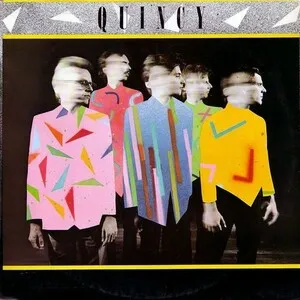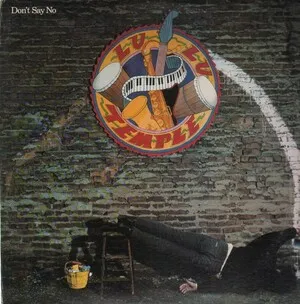Quincy (aka Lulu Temple)
Years before forming the power pop band Smash Palace, brothers Stephen and Brian Butler were members of a new wave band called Quincy. Stephen played guitar, while Brian shared lead vocal duties with bassist Gerald Emerick. Their other two bandmates were drummer Bob Holden and a keyboardist called Metro (aka Wally Smith). This band was originally formed in Haddon Heights, NJ in 1976, and recorded only one long-lost album for Columbia Records in 1980.
The self-titled Quincy album is steeped in the new wave stylings of its day, inviting comparisons to Elvis Costello, Joe Jackson, and the Cars. But its twelve tracks are rooted in power pop, with delectable melodies and hooks that make them timeless. Although a Lennon and McCartney influence is most noticeable on “Grow Up” and “Dime Store Lies”, the Beatles influence can actually be detected beneath the sleek surfaces of nearly all of the tracks. There isn’t a dull song in the dozen. Despite the production (by Tim Friese-Greene, later a member of Talk Talk) and packaging, Quincy didn’t seem to be trying too hard to be hip. At its core, Quincy was just a good, likable rock and roll album that was in tune with the times. It’s one of the unsung albums of its genre and year.
Sadly, Quincy’s career sank when they faced legal action by Quincy Jones over the use of his name(!). They were forced to change the name of the band, and they took on the unappealing moniker Lulu Temple. They recorded just one ill-fated EP under that name in 1983. The four tracks on Don’t Say No found the same quintet attempting to emulate the British synth-pop bands that were then dominating MTV. The title track is reasonably catchy, with a saxophone sound that causes it to resemble some of the era’s mainstream pop hits. But the static “Posing For Pictures” and the dance-club-oriented “Can’t Stand Still” wear out their welcome quickly. It’s easy to understand why the Butler brothers were unhappy with the band’s musical direction, and left Lulu Temple to form Smash Palace. The best track on the EP is the last one: “Hey Girl” is the most Quincy-like song here, possessing a type of new wave bounce similar to the one that made the 1980 album so likable.
The EP should not be confused with the 12-inch single for “Don’t Say No”, which contains a nearly seven-minute extended version of the EP’s title track on its A-side. On the B-side, there is a single edit of the song (which sounds a lot like the EP version) and a six-minute instrumental dub version (which does contain a snippet of the song’s chorus at the end).
4/10/2020 Update: In February 2020, a new Quincy album titled 35 Years On was released on the Kool Kat label, featuring six new studio tracks recorded by the reunited Stephen Butler and Wally Smith. These new power pop tracks are less reminiscent of the new wave era than of earlier bands like the Byrds ("Liberty Bell") and the Kinks ("Something To Smile About", "Words Are Words"). However, the album also contained two live tracks ("Always In The News" and "Privileged Few") recorded live at CBGB's in 1979, which are full of the more Elvis Costello-like qualities of the 1980 album.

Quincy “Quincy” (Columbia NJC 36471) 1980
Track Listing:
1. Turn the Other Way Around
2. Critics' Choice
3. Don't Knock on My Door
4. Always in the News
5. Dime Store Lies
6. Can't Live in a Dream
7. Just a Tragedy
8. Stop Now
9. Grow Up
10. Roamin' Catholic
11. Stuck on You
12. Ordinary Town

Lulu Temple “Don’t Say No” EP (Columbia 5C 38552) 1983
Track Listing:
1. Don’t Say No (3:54)
2. Posing For Pictures (5:02)
3. Can’t Stand Still (7:48)
4. Hey Girl (4:17)

Lulu Temple “Don’t Say No” (12-inch single) (Columbia AS 1687) 1983
Track Listing:
1. Don't Say No (6:50)
2. Don't Say No (Single Edit) (3:40)
3. Don't Say No (Instrumental Dub) (6:00)
See also Smash Palace
The self-titled Quincy album is steeped in the new wave stylings of its day, inviting comparisons to Elvis Costello, Joe Jackson, and the Cars. But its twelve tracks are rooted in power pop, with delectable melodies and hooks that make them timeless. Although a Lennon and McCartney influence is most noticeable on “Grow Up” and “Dime Store Lies”, the Beatles influence can actually be detected beneath the sleek surfaces of nearly all of the tracks. There isn’t a dull song in the dozen. Despite the production (by Tim Friese-Greene, later a member of Talk Talk) and packaging, Quincy didn’t seem to be trying too hard to be hip. At its core, Quincy was just a good, likable rock and roll album that was in tune with the times. It’s one of the unsung albums of its genre and year.
Sadly, Quincy’s career sank when they faced legal action by Quincy Jones over the use of his name(!). They were forced to change the name of the band, and they took on the unappealing moniker Lulu Temple. They recorded just one ill-fated EP under that name in 1983. The four tracks on Don’t Say No found the same quintet attempting to emulate the British synth-pop bands that were then dominating MTV. The title track is reasonably catchy, with a saxophone sound that causes it to resemble some of the era’s mainstream pop hits. But the static “Posing For Pictures” and the dance-club-oriented “Can’t Stand Still” wear out their welcome quickly. It’s easy to understand why the Butler brothers were unhappy with the band’s musical direction, and left Lulu Temple to form Smash Palace. The best track on the EP is the last one: “Hey Girl” is the most Quincy-like song here, possessing a type of new wave bounce similar to the one that made the 1980 album so likable.
The EP should not be confused with the 12-inch single for “Don’t Say No”, which contains a nearly seven-minute extended version of the EP’s title track on its A-side. On the B-side, there is a single edit of the song (which sounds a lot like the EP version) and a six-minute instrumental dub version (which does contain a snippet of the song’s chorus at the end).
4/10/2020 Update: In February 2020, a new Quincy album titled 35 Years On was released on the Kool Kat label, featuring six new studio tracks recorded by the reunited Stephen Butler and Wally Smith. These new power pop tracks are less reminiscent of the new wave era than of earlier bands like the Byrds ("Liberty Bell") and the Kinks ("Something To Smile About", "Words Are Words"). However, the album also contained two live tracks ("Always In The News" and "Privileged Few") recorded live at CBGB's in 1979, which are full of the more Elvis Costello-like qualities of the 1980 album.
Quincy “Quincy” (Columbia NJC 36471) 1980
Track Listing:
1. Turn the Other Way Around
2. Critics' Choice
3. Don't Knock on My Door
4. Always in the News
5. Dime Store Lies
6. Can't Live in a Dream
7. Just a Tragedy
8. Stop Now
9. Grow Up
10. Roamin' Catholic
11. Stuck on You
12. Ordinary Town
Lulu Temple “Don’t Say No” EP (Columbia 5C 38552) 1983
Track Listing:
1. Don’t Say No (3:54)
2. Posing For Pictures (5:02)
3. Can’t Stand Still (7:48)
4. Hey Girl (4:17)
Lulu Temple “Don’t Say No” (12-inch single) (Columbia AS 1687) 1983
Track Listing:
1. Don't Say No (6:50)
2. Don't Say No (Single Edit) (3:40)
3. Don't Say No (Instrumental Dub) (6:00)
See also Smash Palace
Comments